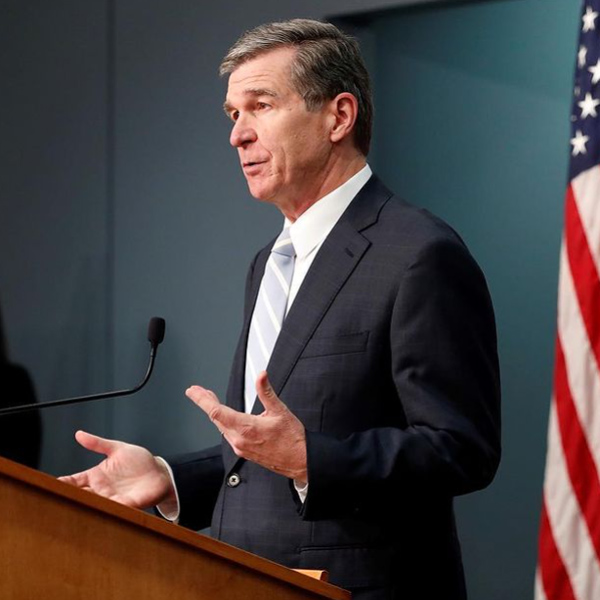North Carolina Gov. Roy Cooper (D) issued an executive order Wednesday setting an offshore wind target of 2.8 GW by 2030 and 8 GW by 2040, citing both the state’s clean energy goals and economic development opportunities.
Cooper said the development would help the state reduce greenhouse gas emissions while claiming a share of the estimated 85,000 jobs and $140 billion in OSW capital expenditures along the Atlantic Coast by 2035. The state’s Clean Energy Plan calls for a 70% reduction in power sector GHG emissions from 2005 levels by 2030 and carbon neutrality by 2050.
In March, the state Department of Commerce released a report that concluded the state’s manufacturing sector was well positioned for a role in the OSW supply chain. (See Report: Offshore Wind Poised to Boom in North Carolina.)

Cooper emphasized that wind farms “can coexist with North Carolina’s military installations,” which he noted are responsible for 600,000 jobs and contribute $70 billion annually to the state’s economy. “The leadership of this state … would not jeopardize these important military installations,” he said.
Cooper directed the state departments of Commerce, Environmental Quality and Military and Veterans Affairs to coordinate OSW efforts and work with the Pentagon and the federal Bureau of Ocean Energy Management (BOEM). The state agencies will coordinate their work through the existing Offshore Wind Interagency Workgroup.
Cooper also ordered creation of the Taskforce for Offshore Wind Economic Resource Strategies (NC TOWERS) to advise the state’s efforts, with representatives from state and local government, the OSW industry, economic development, military, higher education, environmental protection and the marine and tourism industries.
The state also will seek to develop the supply chain for the projects through the Southeast and Mid-Atlantic Regional Transformative Partnerships for Offshore Wind Energy Resources (SMART-POWER), a partnership announced last October with Maryland and Virginia. (See Md., NC, Va. to Team up on Offshore Wind.)
Duke Energy, the state’s largest utility, included offshore wind in two of the potential pathways in the integrated resource plan (IRP) it submitted to the North Carolina Utilities Commission in September.
Three Wind Energy Areas
BOEM has identified three wind energy areas (WEA) off the state’s coast. In 2017, it awarded a lease for the Kitty Hawk WEA to Avangrid Renewables (NYSE:AGR), a 122,405-acre site the company says has capacity for 2.5 GW. Construction is expected to begin in 2025.
The Wilmington West WEA (51,595 acres) and Wilmington East WEA (133,590 acres) have not been leased, but a BOEM spokesperson told NetZero Insider Thursday the agency is planning an auction in the Carolina Long Bay region, which includes the WEAs, next year.

The spokesperson said BOEM’s decision on future auctions will be informed by the Regional Carolina Long Bay Intergovernmental Renewable Energy Task Force, ocean users, and other stakeholders.
The Southern Alliance for Clean Energy said 8 GW of OSW would power more than 2 million homes, about one-fifth to one-quarter of the state’s total electricity demand. The group said the three existing WEAs could produce up to 6 GW of OSW, meaning new areas will need to be identified and leased to meet the goal.
President Biden has set a goal of adding 30 GW of OSW nationwide by 2030. On Tuesday, BOEM announced plans to assess potential OSW development on the Outer Continental Shelf in the Gulf of Mexico. In May it announced plans to offer leases for California’s first offshore wind areas. (See BOEM to Offer Leases for Calif. Offshore Wind.)
But OSW is expected to grow first along the Atlantic coast as New York, New Jersey, Massachusetts, Virginia, Connecticut, Maryland and Rhode Island have set OSW targets totaling more than 30 GW.
“Offshore wind can be a significant part of North Carolina’s transition to clean energy, as long as it is carefully developed to protect sensitive marine and coastal environments, from endangered whales and fisheries to onshore wetlands,” said Derb Carter, North Carolina Office director for the Southern Environmental Law Center, after Cooper’s announcement. “However, we need urgent action to reduce carbon pollution today and the multi-year process for wind will not achieve this, even though it is an important part of a long-term clean energy plan for our state.”
Carter asked Cooper to support her group’s petition for rulemaking seeking to have North Carolina establish a CO2 trading program and join the Regional Greenhouse Gas Initiative. The North Carolina Environmental Management Commission’s Air Quality Committee will hold a hearing on the petition, filed on behalf of Clean Air Carolina and the North Carolina Coastal Federation, June 15.



